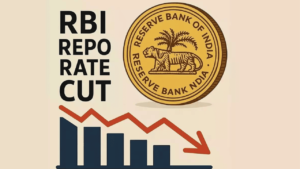When the Reserve Bank of India (RBI) makes a move on the repo rate, the impact is far-reaching—whether you’re a first-time homebuyer, a mutual fund investor, or simply someone trying to make smart money decisions in a volatile economy.

In April 2025, the RBI reduced the repo rate by 25 basis points to 6.00%, marking the second consecutive rate cut of the year. While that might sound like just another number to some, the truth is, it affects all of us more than we realize. Let’s break it down—not just what happened, but why it matters to you personally.
What Is the RBI Repo Rate—and Why Should You Care
Let’s be honest—financial jargon like “repo rate” can seem dry and distant. But if you’ve ever taken out a loan, checked the Nifty, or reviewed your mutual fund performance, the repo rate plays a silent yet powerful role in your financial life.
So, what exactly is the repo rate?
In simple terms, it’s the interest rate at which the RBI lends money to commercial banks. And it’s one of the key tools the central bank uses to manage:
- Inflation
- Liquidity
- Economic growth and stability
When the RBI cuts the repo rate, it’s essentially making money cheaper for banks to borrow. That, in turn, helps banks lower their lending rates for people like us. Think of it like a domino effect—one that could reduce your EMIs, boost market investments, and give the broader economy a push in the right direction.
Why Did the RBI Repo Rate Cut 2025?
This wasn’t a random decision—it was a carefully calculated response to a complex set of economic challenges.
Here’s what pushed the RBI to act:
-
Global Trade Pressures
A sharp escalation in U.S. tariffs, especially a 104% levy on Chinese imports, sent shockwaves through global markets. India, being closely tied to global supply chains, couldn’t ignore the implications. -
Slowing Growth Outlook
The RBI revised its GDP growth forecast for FY2026 from 6.7% down to 6.5%. While not a dramatic drop, it signaled caution, and the need for proactive measures. -
Tamed Inflation
Consumer inflation has been moderating, giving the RBI room to cut rates without overheating the economy. The forecast was brought down from 4.2% to 4%—a reassuring signal for investors and consumers alike. -
Policy Stance Shift
Alongside the rate cut, the RBI also changed its policy stance from “neutral” to “accommodative”—a strong indicator that further rate cuts could follow if needed.
This move isn’t just about controlling inflation or boosting GDP—it’s about maintaining confidence in the system and keeping the wheels of the economy turning.
What Does This Mean for You?
You might be wondering—“Okay, I get the macro side… but how does this impact my day-to-day life?” Let’s make it real.
1. Lower EMIs = More Savings
If you’re repaying a home loan, car loan, or personal loan, a lower repo rate can lead to lower interest rates from your bank. That means your monthly EMIs may drop, giving you more breathing room in your budget.
2. A Boost for Mutual Fund Investors
When interest rates fall, equities often shine. With borrowing costs lower, companies can grow faster—and investors benefit. Consider equity mutual funds like:
- Canara Robeco ELSS Tax Saver Regular – Growth
5-Year Return: 22.39% - HSBC Large Cap Fund Direct-Growth
5-Year Return: 21.5%
Funds like these stand to benefit as market sentiment improves, especially in a low-rate, pro-growth environment.
3. Your Savings Might Earn Less
On the flip side, lower rates also mean fixed deposits and savings accounts may offer smaller returns. If you’re someone who relies on conservative investment tools, this could be a good time to reassess your portfolio.
How Did the Market React?
You’d expect the markets to cheer a rate cut—but 2025 had other plans.
On the day of the announcement, the Nifty dipped to 22,399.15, down 0.72%, and the BSE Sensex also saw a mild decline. Why the drop? Investors were spooked by global cues—particularly the U.S.-China trade tensions—and were cautious despite the RBI’s positive signal.
Meanwhile, the Indian rupee also slipped to a three-week low, impacted by a weaker Chinese yuan and uncertainty around global trade policies.
Moral of the story? The repo rate isn’t the only factor in play—but it’s still a major piece of the puzzle.
More Read:- Click Here
Final Thoughts: The Repo Rate Is More Than Just a Number
So here’s the big takeaway: the RBI’s 2025 repo rate cut isn’t just about banks and bonds. It’s about you—your loans, your savings, your investments, and your financial future.
It’s about recognizing signals, connecting the dots, and adjusting your strategy so you’re not caught off guard when the next change happens.
Ask yourself:
- Are your current investments aligned with changing market conditions?
- Could refinancing your loan put more money back in your pocket?
- Are you actively growing your financial knowledge?
If not, don’t worry—it’s never too late to start. Because when it comes to building wealth, it’s not just about how much you earn. It’s about how well you adapt.
Stay smart. Stay curious. And let rate cuts like these become opportunities—not just headlines.
Also Read:- US Raises Tariffs on China to 104%